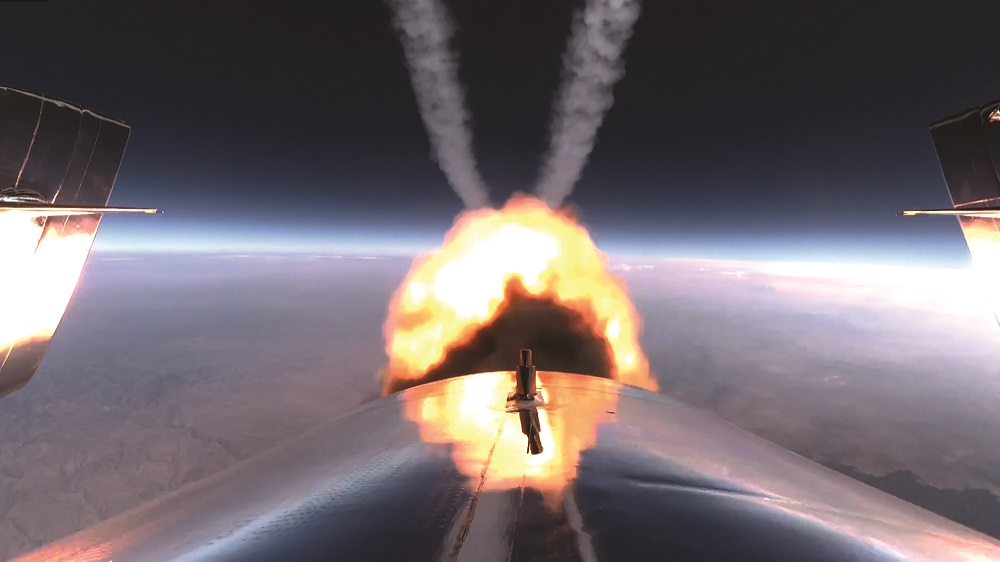LOMPOC, Calif. — The Federal Aviation Administration will not allow Virgin Galactic to resume flights of its SpaceShipTwo suborbital spaceplane until it completes an investigation into a problem on the vehicle’s previous flight in July.
In a Sept. 2 statement, the FAA said it is overseeing a Virgin Galactic mishap investigation into the July 11 flight of SpaceShipTwo, called “Unity 22” by the company, which appeared to go as planned but in fact suffered a problem that caused it to stray from its restricted airspace.
“Virgin Galactic may not return the SpaceShipTwo vehicle to flight until the FAA approves the final mishap investigation report or determines the issues related to the mishap do not affect public safety,” the agency stated.
The statement came a day after the publication of an article by The New Yorker that revealed that the two SpaceShipTwo pilots ignored an “entry glide cone warning” during the July 11 flight from Spaceport America in New Mexico. The flight took them and four others on board, including Virgin Galactic founder Richard Branson, to the edge of space and back with no indication at the time of any problems.
That warning indicated that the vehicle was outside the volume of space known as the glide cone where it had enough energy to glide back to a runway landing at the spaceport. The warning appeared late in the powered portion of the flight, indicating that the vehicle was not climbing steeply enough.
Company sources cited in the article said that, in the event of such a warning, SpaceShipTwo’s hybrid rocket motor should have been shut down, aborting the flight. Instead, the pilots, David Mackay and Mike Masucci, let the motor fire for the full duration. An abort could have prevented SpaceShipTwo from reaching the 80-kilometer altitude that the company defines as space, thwarting Branson’s bid to get to space before Blue Origin founder Jeff Bezos did so on his company’s New Shepard suborbital vehicle July 20.
During SpaceShipTwo’s glide back to the runway at Spaceport America, it flew for a time outside of its designated airspace, according to flight tracking data. The vehicle landed safely.
In a Sept. 1 statement, Virgin Galactic said it disputed “the misleading characterizations and conclusions” of the article. However, it did acknowledge that SpaceShipTwo “did drop below the altitude of the airspace that is protected for Virgin Galactic missions for a short distance and time,” which it estimated at 101 seconds.
Virgin Galactic blamed high winds at upper altitudes for the deviation in trajectory that triggered the warning. “Our pilots responded appropriately to these changing flight conditions exactly as they were trained and in strict accordance with our established procedures,” the company said. “Although the flight’s ultimate trajectory deviated from our initial plan, it was a controlled and intentional flight path that allowed Unity 22 to successfully reach space and land safely at our Spaceport in New Mexico.”
The former director of Virgin Galactic’s test flight program criticized the company. “The most misleading statement today was @virgingalactic’s,” tweeted Mark “Forger” Stucky. “The facts are the pilots failed to trim to achieve the proper pitch rate, the winds were well within limits, they did nothing of substance to address the trajectory error, & entered Class A airspace without authorization.”
Stucky, who piloted SpaceShipTwo on its first suborbital spaceflight in December 2018 and had been an internal critic of some flight test practices at the company, was let go by Virgin Galactic a week after the July 11 flight.
Hours before the FAA statement, Virgin Galactic announced plans for its next SpaceShipTwo flight. The Unity 23 flight will be a dedicated flight for the Italian Air Force carrying three Italian researchers and one Virgin Galactic employee in the cabin. The flight will be piloted by Masucci and CJ Sturckow. Unity 23 is the last before the company goes into a maintenance period for both the spaceplane and its WhiteKnightTwo aircraft scheduled to run to the middle of 2022.
“Being selected by the Italian Air Force to support their microgravity research is a testament to the unique scientific capabilities of our spaceflight system,” Michael Colglazier, chief executive of Virgin Galactic, said in a Sept. 2 company statement. “This flight will be remembered as an important milestone in unlocking the transformative potential of repeatable and reliable access to space for years to come.”
The Virgin Galactic announcement made no mention of the mishap investigation, but stated it expected to perform the Unity 23 mission in late September or early October. The FAA did not disclose when it expected to give its approval for the company to resume flights.
